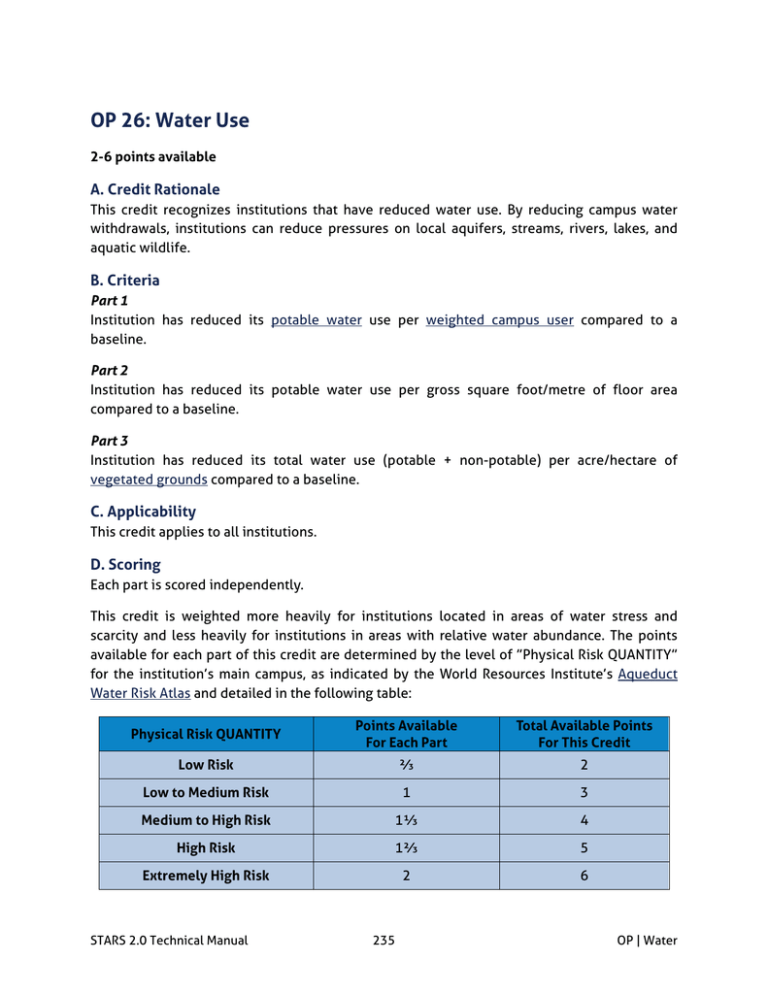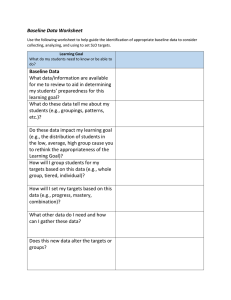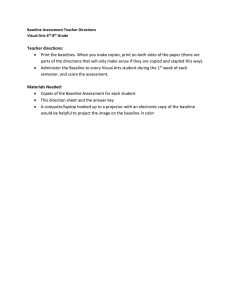OP 26: Water Use
advertisement

OP 26: Water Use
2-6 points available
A. Credit Rationale
This credit recognizes institutions that have reduced water use. By reducing campus water
withdrawals, institutions can reduce pressures on local aquifers, streams, rivers, lakes, and
aquatic wildlife.
B. Criteria
Part 1
Institution has reduced its potable water use per weighted campus user compared to a
baseline.
Part 2
Institution has reduced its potable water use per gross square foot/metre of floor area
compared to a baseline.
Part 3
Institution has reduced its total water use (potable + non-potable) per acre/hectare of
vegetated grounds compared to a baseline.
C. Applicability
This credit applies to all institutions.
D. Scoring
Each part is scored independently.
This credit is weighted more heavily for institutions located in areas of water stress and
scarcity and less heavily for institutions in areas with relative water abundance. The points
available for each part of this credit are determined by the level of ”Physical Risk QUANTITY”
for the institution’s main campus, as indicated by the World Resources Institute’s Aqueduct
Water Risk Atlas and detailed in the following table:
Physical Risk QUANTITY
Points Available
For Each Part
Total Available Points
For This Credit
Low Risk
2
Low to Medium Risk
1
3
Medium to High Risk
1
4
High Risk
1
5
Extremely High Risk
2
6
STARS 2.0 Technical Manual
235
OP | Water
Points earned are calculated according to the formulas below. Please note that users do not
have to calculate the number of points available and the number of points earned themselves;
points will be calculated automatically when the data listed under Section E: Reporting Fields
is entered in the online Reporting Tool.
Part 1
Institutions earn the maximum points available for Part 1 of this credit by achieving a 30
percent or larger reduction in potable water use per weighted campus user compared to a
baseline. Incremental points are awarded for smaller reductions. For example, an institution
that reduced its potable water use by 15 percent would earn half of the points available for
Part 1of this credit.
STARS awards only positive points; points will not be deducted if potable water use per
weighted campus user increased rather than decreased during the time period.
Points Earned = [ E / 0.3 ] × { [ (A/B) - (C/D) ] / (A/B) }
A=
Potable water use, baseline year (US gallons/cubic metres)
B=
Weighted campus users, baseline year
C=
Potable water use, performance year (US gallons/cubic metres)
D=
Weighted campus users, performance year
E=
Points available for Part 1
Part 2
Institutions earn the maximum points available for Part 2 of this credit by achieving a 30
percent or larger reduction in potable water use per gross square foot/metre of floor area
compared to a baseline. Incremental points are awarded for smaller reductions. For example,
an institution that reduced its potable water use by 15 percent would earn half of the points
available for Part 2 of this credit.
STARS awards only positive points; points will not be deducted if potable water use per gross
square foot of building space increased rather than decreased during the time period.
Points Earned = [ E / 0.3 ] × { [ (A/B) - (C/D) ] / (A/B) }
A=
Potable water use, baseline year (US gallons/cubic metres)
B=
Gross floor area of building space, baseline year (gross square feet/metres)
C=
Potable water use, performance year (US gallons/cubic metres)
D=
Gross floor area of building space, performance year (gross square feet/metres)
E=
Points available for Part 2
STARS 2.0 Technical Manual
236
OP | Water
Part 3
Institutions earn the maximum points available for Part 3 of this credit by achieving a 30
percent or larger reduction in total water use per acre/hectare of vegetated grounds compared
to a baseline. Incremental points are awarded for smaller reductions. For example, an
institution that reduced its total water use by 15 percent would earn half of the points
available for Part 2 of this credit.
STARS awards only positive points; points will not be deducted if water use per acre/hectare
of vegetated grounds increased rather than decreased during the time period.
Points Earned = [ E / 0.3 ] × { [ (A/B) - (C/D) ] / (A/B) }
A=
Total water use, baseline year (US gallons/cubic metres)
B=
Area of vegetated grounds, baseline year (acres/hectares)
C=
Total water use, performance year (US gallons/cubic metres)
D=
Area of vegetated grounds, performance year (acres/hectares)
E=
Points available for Part 3
Scoring Example: Water Use
Example College’s ”Physical Risk QUANTITY” for water is Extremely High according to the
World Resources Institute’s Aqueduct Water Risk Atlas, making 2 points available for each
part of the credit.
Part 1
x
x
x
x
Used 1,000,000 gallons of potable water in 2005 (A)
Had 2,000 weighted campus users in 2005 (B)
Used 900,000 gallons of potable water in 2013 (C)
Had 2,000 weighted campus users in 2013 (D)
Points Earned = (2 / 0.3) × { [ (A/B) - (C/D) ] / (A/B) }
= 6 × { [ (1,000,000/2,000) - (900,000/2,000) ] / (1,000,000/2,000) }
= 6 × { [ 500 - 450] / 500 }
= 6 × 50 / 500
= 6 × 0.10
= 0.667 points earned for Part 1
STARS 2.0 Technical Manual
237
OP | Water
Scoring Example: Water Use (continued)
Part 2
x
x
x
x
Used 1,000,000 gallons of potable water in 2005 (A)
Had 2,000,000 gross square feet of floor area in 2005 (B)
Used 900,000 gallons of potable water in 2013 (C)
Had 2,500,000 gross square feet of floor area in 2013 (D)
Points Earned = (2 / 0.3) × { [ (A/B) - (C/D) ] / (A/B) }
=
6 × { [ (1,000,000/2,000,000)
(1,000,000/2,000,000) }
= 6 × { [ 0.5 – 0.36] / 0.5 }
= 6 × 0.14 / 0.5
= 6 × 0.28
= 1.867 points earned for Part 2
Part 3
x
x
x
x
-
(900,000/2,500,000)
]
/
Used 1,000,000 gallons of potable and non-potable water in 2005 (A)
Had 100 acres of vegetated grounds in 2005 (B)
Used 900,000 gallons of potable and non-potable water in 2013 (C)
Had 120 acres of vegetated grounds in 2013 (D)
Points Earned = (2 / 0.3) × { [ (A/B) - (C/D) ] / (A/B) }
= 6 × { [ (1,000,000/100) - (900,000/120) ] / (1,000,000/100) }
= 6 × { [ 10,000 – 7,500] / 10,000 }
= 6 × 2,666.67 / 11,000
= 6 × 0.25
= 1.667 points earned for Part 3
Total Points Earned = 0.667 + 1.867 + 1.667
= 4.2 points
STARS 2.0 Technical Manual
238
OP | Water
E. Reporting Fields
Required
Ƒ Level of ”Physical Risk QUANTITY” for the institution’s main campus as indicated by the
World Resources Institute’s Aqueduct Water Risk Atlas (Low, Low to Medium, Medium
to High, High, or Extremely High)
Ƒ
Total water use (potable and non-potable combined), performance year (US
gallons/cubic metres)
Ƒ
Potable water use, performance year (US gallons/cubic metres)
Ƒ
Figures used to determine “Weighted Campus Users” during the performance year:
o
Number of residential students, performance year (annualized headcount)
o
Number of residential employees, performance year (annualized headcount)
o
Number of in-patient hospital beds, performance year
o
Full-time equivalent enrollment, performance year (annualized FTE)
o
Full-time equivalent of employees, performance year (annualized FTE)
o
Full-time equivalent of distance education students, performance year (annualized
FTE)
Ƒ
Gross floor area of building space, performance year (square feet/metres)
Ƒ
Area of vegetated grounds, performance year (acres/hectares) (Athletic fields and land
dedicated to food production may be excluded)
Ƒ
Start date, performance year or 3-year period
Ƒ
End date, performance year or 3-year period
Ƒ
Total water use (potable and non-potable combined), baseline year (US gallons/cubic
metres)
Ƒ
Potable water use, baseline year (US gallons/cubic metres)
Ƒ
Figures used to determine “Weighted Campus Users” during the baseline year:
o
Number of residential students, baseline year (annualized headcount)
o
Number of residential employees, baseline year (annualized headcount)
o
Number of in-patient hospital beds, baseline year
o
Full-time equivalent enrollment, baseline year (annualized FTE)
o
Full-time equivalent of employees, baseline year (annualized FTE)
o
Full-time equivalent of distance education students, baseline year (annualized FTE)
Ƒ
Gross floor area of building space, baseline year (square feet/metres)
Ƒ
Area of vegetated grounds, baseline year (acres/hectares) (Athletic fields and land
dedicated to food production may be excluded)
Ƒ
Start date, baseline year or 3-year period
STARS 2.0 Technical Manual
239
OP | Water
Ƒ
End date, baseline year or 3-year period
Ƒ
An affirmation that the submitted information is accurate to the best of a responsible
party’s knowledge and contact information for the responsible party. The responsible
party should be a staff member, faculty member, or administrator who can respond to
questions regarding the data once submitted and available to the public.
Conditional
Required if end date of the baseline year/period is 2004 or earlier:
Ƒ A brief description of when and why the water use baseline was adopted (e.g. in
sustainability plans and policies or in the context of other reporting obligations)
Optional
Ƒ Water recycled/reused on campus, performance year (US gallons/cubic metres)
Ƒ
Recycled/reused water withdrawn from off-campus sources, performance year (US
gallons/cubic metres)
Ƒ
A brief description of any of the following water conservation and efficiency initiatives
employed by the institution:
o
Water recovery and reuse
o
Water metering and management systems
o
Building retrofits, e.g. to install high efficiency plumbing fixtures and fittings
o
Replacing appliances, equipment and systems with water-efficient alternatives
o
Water-efficient landscape design (e.g. xeriscaping)
o
Weather-informed irrigation technologies
o
Other water conservation and efficiency initiatives (please specify)
Ƒ
The website URL where information about the institution’s water conservation and
efficiency initiatives is available
Ƒ
Notes about the submission
F. Measurement
Timeframe
Performance Year
Report the most recent data available from the three years prior to the anticipated date of
submission. Institutions may use the most recent single year for which data is available or an
average from throughout the period. Institutions may choose the annual start and end dates
that work best with the data they have (e.g. fiscal or calendar year), as long as data are
reported from a consecutive 12-month (or 3-year) period.
Report building space, campus area, and annualized population figures from the same time
period as that from which water use data are drawn (e.g. the consecutive 12-month or 3-year
STARS 2.0 Technical Manual
240
OP | Water
period that most closely overlaps with the water use performance period). Institutions may
report building space and campus area using an average from throughout the period or a
snapshot at a single representative point during the period.
Baseline Year
Report data from the baseline year, which may be:
x Any year from 2005 to the present
x A baseline year, 1990 to 2004, that the institution has adopted as part of its sustainability
plans or policies or in the context of other reporting obligations
Recommended best practices for defining a baseline include:
x Using the average of three consecutive years to reduce the impact of outliers.
x Using the same baseline year for multiple credits to reduce reporting requirements. For
example, institutions using 2005 for all STARS credits that are baseline-based would only
have to calculate baseline weighted campus user data once.
x Ensuring that baseline and performance year data are valid and reliable (e.g. that the data
were gathered in the same manner)
Institutions without valid and reliable historical data should use performance year data for
both the baseline and performance year. Following this approach, an institution would not be
able to claim points during its first STARS submission, but would be able to use its newly
established baseline for subsequent submissions.
Institutions may choose the start and end dates that work best with the data they have (e.g.
fiscal or calendar year), as long as data are reported from a consecutive 12-month (or 3-year)
period.
Report building space, campus area, and annualized population figures from the same period
as that from which water use data are drawn (e.g. the consecutive 12-month or 3-year period
that most closely overlaps with the water use baseline period). Institutions may report
building space and campus area using an average from throughout the period or a snapshot at
a single representative point during the period (e.g. the fall figures reported to IPEDS by U.S.
institutions).
Sampling and Data Standards
To the extent possible, include all water that was used by the institution when reporting for
this credit; reporting on a sample or subset of water use is not allowed. Total water use is the
total volume of water, potable and non-potable, withdrawn by the institution regardless of
source, i.e. surface water, ground water, rainwater harvested directly and stored by the
institution for use, reclaimed wastewater from off-campus sources, and water from municipal
water supplies and water utilities. If data on water use values are not available, institutions
may work with their facilities department and water utility to estimate usage figures based on
billing totals.
STARS 2.0 Technical Manual
241
OP | Water
Water that is recycled/reused on campus should only be counted toward water use once (at
initial withdrawal from its source) and excluded at subsequent uses.
Athletic fields and land dedicated to food production may be excluded from the area of
vegetated grounds as long as they are excluded from both baseline year and performance
year data.
STARS 2.0 Technical Manual
242
OP | Water


